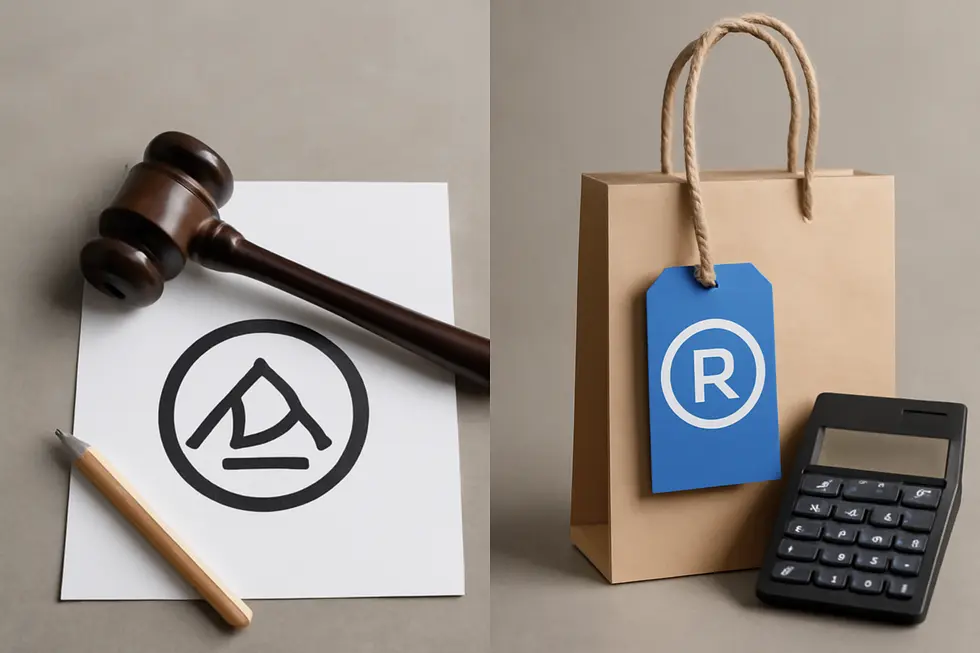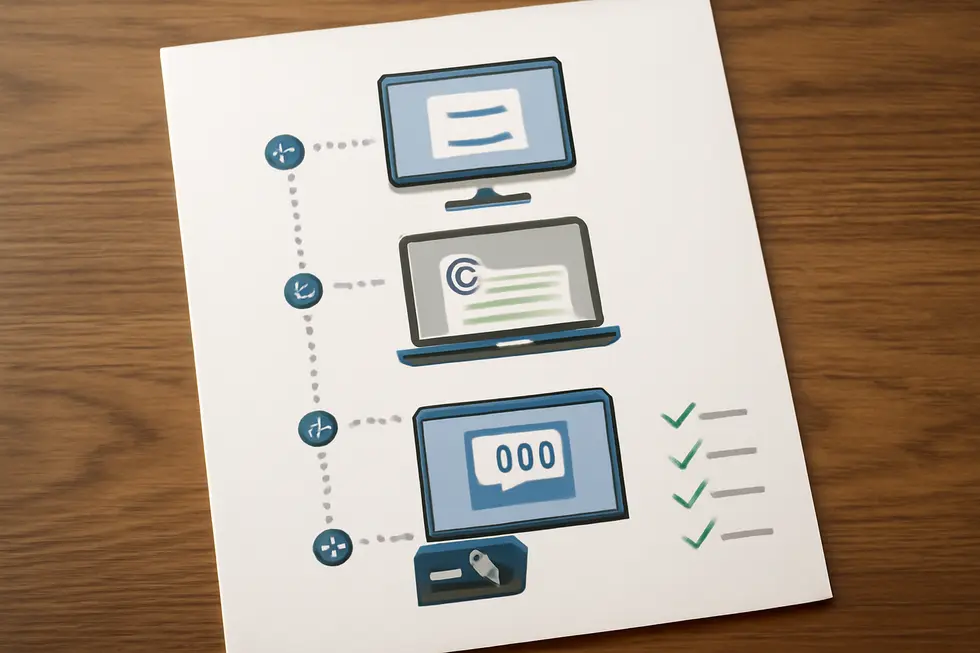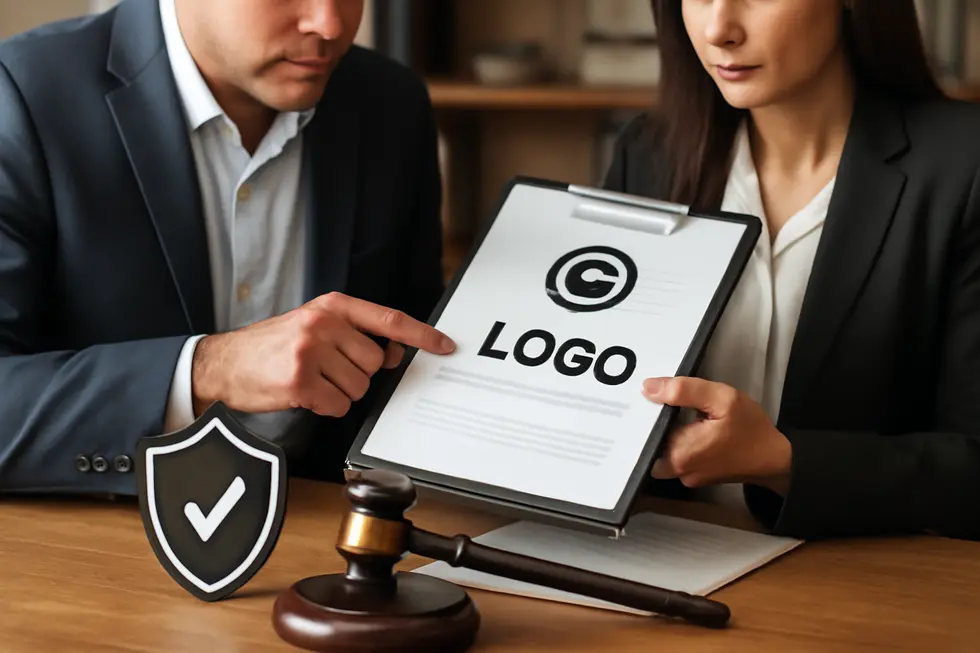Introduction
A logo represents the visual core of your business’s identity, making it critical to protect this creative asset from unauthorized use. Copyrighting your logo ensures legal recognition of your design as original artwork, safeguarding your brand’s unique image. This guide walks business owners through understanding the copyright registration process, clarifies how copyright and trademark protections differ and complement each other, details the step-by-step registration procedures, and highlights the legal benefits and enforcement powers that come from a registered logo. By gaining this comprehensive insight, you’ll be equipped to protect your logo effectively, preserving your brand’s value and competitive edge.
Tables of Contents
Chapter 1: How to Copyright a Logo: Understanding Copyright Registration Process
- Navigating the Copyright Registration Journey: A Step-by-Step Approach to Protecting Your Logo’s Artistic Design
- Navigating Logo Protection: Distinguishing Copyright from Trademark Registration
- Navigating the Copyright Registration Process: Legal Essentials and Practical Steps for Logo Protection
Chapter 2: How to Copyright a Logo: Distinguishing Copyright from Trademark Protection
- Decoding Logo Protection: How Copyright and Trademark Safeguard Creativity and Brand Identity
- Understanding Trademark Protection: Safeguarding Your Logo’s Brand Identity
- Navigating the Registration Processes: Securing Copyright and Trademark Protection for Your Logo
Chapter 3: How to Copyright a Logo: Step-by-Step Registration Procedures
- Navigating the Copyright Registration Journey to Protect Your Logo’s Artistic Design
- Navigating the Copyright Registration Process: From Application Submission to Certificate Issuance
- Navigating Logo Protection: Detailed Steps for Copyright and Trademark Registration
Chapter 4: How to Copyright a Logo: Legal Benefits and Enforcement of Registered Logos
- Unlocking Stronger Legal Rights: The Advantages of Trademark Registration for Your Logo
- Navigating Logo Protection: A Practical Guide to Registering and Enforcing Your Logo’s Legal Rights
- Protecting Your Registered Logo: Effective Legal Measures and Remedies
Chapter 1: How to Copyright a Logo: Understanding Copyright Registration Process

1. Navigating the Copyright Registration Journey: A Step-by-Step Approach to Protecting Your Logo’s Artistic Design
Copyright registration for a logo is a structured process designed to protect its unique artistic expression. Since logos fall under visual artistic works, the first step is recognizing this classification to ensure proper filing. To begin, you need to prepare key documents including the completed application form, a clear representation of the logo (digital or physical), a description detailing the logo’s design elements, and valid identification for the creator or applicant.
The filing typically happens online via the official Copyright Office portal, which streamlines the process and reduces fees compared to mail submissions. Upon submission, a government fee is payable; this varies based on the work’s type and whether you file electronically or on paper. After your application is accepted, the office assigns a diary number and initiates a review. A public notice period follows, lasting about 30 days, during which any objections can be raised.
If no unresolved challenges arise, the office issues an official certificate confirming copyright registration. This certificate legally affirms your exclusive rights over the logo’s artistic creation, although it does not extend to the logo’s commercial use or brand identity aspects.
It’s important to understand that copyright safeguards the creative design but does not cover the logo as a trademark. For legal coverage over the logo’s use in commerce, trademark registration is necessary. For more detail about the registration steps and official guidance, the U.S. Copyright Office website offers comprehensive resources. You can also explore related insights at trademark2go.com’s copyright language resource.
For official registration procedure details, visit: https://balajicertification.com/copyright-registration/copyright-registration-process/
2. Navigating Logo Protection: Distinguishing Copyright from Trademark Registration
Protecting a logo involves understanding two key forms of intellectual property registration: copyright and trademark. While both can secure aspects of a logo, they serve distinct purposes and follow different procedures. Copyright registration safeguards the logo’s original artistic design, treating it as a visual work under creative protection. This process requires submitting a clear copy of the logo, a description, and proof of authorship to the U.S. Copyright Office. Upon approval, the creator gains legal documentation that supports enforcement against unauthorized copying. The copyright term generally lasts the life of the author plus seventy years, providing long-term protection for the design itself.
In contrast, trademark registration protects the logo as a symbol that identifies and distinguishes the source of goods or services in commerce. This process begins with a trademark search to ensure uniqueness and avoid conflicts. The application must specify the goods or services the logo represents and is filed with the United States Patent and Trademark Office (USPTO). Following examination and a public opposition period, registration grants exclusive rights to use the logo in business contexts. Trademark protection can last indefinitely, provided the mark remains in active use and is periodically renewed.
The practical difference is that copyright guards the creative work, regardless of use, while trademark guards the logo’s commercial identity. Because of this distinction, many businesses pursue both forms of registration to fully secure their logos against infringement and marketplace confusion. Understanding this differentiation helps logo owners navigate the registration processes effectively and leverage the appropriate protections for their needs. For those interested in the copyright side, the U.S. Copyright Office offers detailed guidance and application portals to streamline registration.
For more on trademark protection related to logos and business branding, explore authoritative resources such as trademark protection for business names and logos.
3. Navigating the Copyright Registration Process: Legal Essentials and Practical Steps for Logo Protection
Copyrighting a logo necessitates recognition of it as an artistic work, demanding a well-defined registration process that protects the creative design. To start, the logo owner must classify the work appropriately when submitting the application to the U.S. Copyright Office. This registration involves providing detailed documentation, including a clear image of the logo, identification or proof of address of the creator or applicant, and if necessary, a power of attorney in case an agent applies on behalf of the creator. The application may be filed online or by mail, accompanied by the prescribed fee. Once submitted, the application enters a review phase where it is published for a 30-day public notice period, allowing any objections to be raised. Absent objections, the copyright is registered, and the applicant receives a certificate that legally confirms ownership and the date of creation.
Understanding the distinction between copyright and trademark registrations is vital since both play complementary roles in protecting logos. Copyright secures the artistic expression of the logo design, while trademark safeguards its use as an identifier in commerce, protecting brand recognition. Businesses often seek trademark registration to guard against confusingly similar marks in the marketplace, which complements copyright’s focus on design originality. Unlike copyright, trademark protection requires conducting preliminary searches, responding to examination inquiries, and maintaining renewal for continued rights. Some logos might also be eligible for design patent protection if their ornamental design meets novelty criteria, adding another layer of legal defense.
For creators seeking to fully protect their logos, securing copyright registration provides foundational assurance of ownership over the artistic design. Combined with trademark registration, it offers robust, enforceable rights in both creative and commercial contexts. More detailed guidance on this registration process can be found in resources explaining the copyright registration steps for logos. For further insights on protecting logos as brand assets, explore our discussion on trademark protection for business names and logos.
Chapter 2: How to Copyright a Logo: Distinguishing Copyright from Trademark Protection

1. Decoding Logo Protection: How Copyright and Trademark Safeguard Creativity and Brand Identity
Copyright and trademark protections serve complementary yet fundamentally different roles when it comes to logos. Copyright safeguards the original artistic or creative expression embedded in a logo, treating it as a work of authorship. This protection arises automatically once the logo is created and fixed in a tangible form, such as a digital image or print. Although registration with the U.S. Copyright Office is optional, it significantly strengthens legal standing, especially in enforcement. Copyright prevents unauthorized copying or reproduction of the artistic elements, safeguarding the design itself as intellectual property.
In contrast, trademark protection focuses on the logo’s role as a brand identifier. It ensures exclusive rights to use the logo in commerce to distinguish products or services from others in the marketplace. Unlike copyright, trademark rights can be established either by first use in commerce or through formal registration with the United States Patent and Trademark Office (USPTO). Registered trademarks grant stronger nationwide protection and the ability to prevent others from using confusingly similar marks that could dilute brand identity.
Because logos function on two levels—both as creative designs and commercial symbols—businesses often pursue both protections for comprehensive security. Copyright covers the design’s originality, while trademark protects how the logo is used to build reputation and consumer recognition. Understanding this distinction is crucial: copyright guards artistic creation, and trademark secures the logo’s commercial presence. This ensures that a logo’s unique design and its identity in the marketplace each receive proper legal defense.
For more insight into trademark protection for business names and logos, see the detailed trademark protection guide.
2. Understanding Trademark Protection: Safeguarding Your Logo’s Brand Identity
Trademark protection plays a vital role in securing a logo’s function as a brand identifier, distinguishing your goods or services from competitors in the marketplace. Unlike copyright, which shields the artistic design of a logo, trademarks focus on protecting the logo’s commercial use to prevent consumer confusion. This protection applies not only to logos but also to names, slogans, and other unique brand elements that signify the source of products or services.
Obtaining trademark rights typically requires registration with the United States Patent and Trademark Office (USPTO). This process involves submitting an application, paying fees, and demonstrating the logo’s use in commerce. Upon registration, the trademark symbol ® can be used, signaling federally granted protection that is enforceable nationwide. Even before registration, marks may be identified with ™ or ℠ to indicate claims of rights in commerce.
Trademark rights can last indefinitely, as long as the owner maintains usage and renews the registration periodically. This contrasts with copyright’s fixed term tied to the creator’s lifetime plus many years. Trademarks primarily serve to prevent others from using confusingly similar logos that could mislead consumers, thereby preserving brand reputation and customer trust.
To maximize protection, many businesses pursue both copyright registration for the logo’s creative artwork and trademark registration to safeguard its role as a distinctive brand identifier. This dual strategy ensures that the logo’s artistic originality and commercial significance are securely protected under the law.
For a deeper dive into the trademark registration process and its nuances, see the detailed guide on trademark protection for business names and logos. Additionally, official information from the USPTO provides authoritative resources on registering and maintaining trademarks to protect your brand effectively.
3. Navigating the Registration Processes: Securing Copyright and Trademark Protection for Your Logo
When protecting a logo, understanding the distinct yet complementary registration processes of copyright and trademark is essential. In the United States, copyright protection arises automatically upon the creation of an original logo, classifying it as an artistic work fixed in a tangible medium. However, registering this copyright with the U.S. Copyright Office amplifies your legal rights. The registration process involves submitting a clear image of the logo through an online form, accompanied by a fee typically ranging between $35 and $50. This registration enables the owner to pursue statutory damages and attorney fees if the copyright is infringed, providing important enforcement leverage.
Trademark protection, by contrast, centers on the logo’s function as a brand identifier in commercial use. Unlike copyright, trademark rights do not arise automatically and require a more involved registration process with the United States Patent and Trademark Office (USPTO). This begins with a comprehensive trademark search to verify the logo’s uniqueness and avoid conflicts. Upon confirming eligibility, an application is filed electronically via the Trademark Electronic Application System (TEAS), detailing design features and the specific goods or services the logo represents. The filing fees start around $250 per class of goods or services, reflecting the scope of protection sought.
After filing, the USPTO reviews the application and may issue office actions requesting clarifications or raising objections. Addressing these promptly is critical to moving toward approval. Once registered, the trademark secures exclusive rights to use the logo in commerce for ten years, with indefinite renewals possible as long as the mark remains active.
This dual-registration strategy allows business owners to protect both the creative expression of their logos under copyright and their commercial identity under trademark law, forming a robust legal shield. For those seeking deeper insight into trademark protection for logos, consulting detailed guides such as trademark protection for business name and logo can be valuable. More information on the copyright registration process can be found at the official U.S. Copyright Office website.
Chapter 3: How to Copyright a Logo: Step-by-Step Registration Procedures

1. Navigating the Copyright Registration Journey to Protect Your Logo’s Artistic Design
Securing copyright protection for a logo involves a clear, methodical registration process that legally recognizes the logo as an original artistic work. First, it’s essential to confirm the logo qualifies under copyright law as an artistic creation, such as a graphic design or drawing. Once confirmed, you gather the necessary materials including a completed application form, a detailed description of the logo, and copies of the logo itself, whether digital or physical. Identification and address verification of the creator or applicant are also required.
The application is typically submitted through the official Copyright Office’s online portal, accompanied by the appropriate government fee. Upon submission, the office assigns a diary number to track the application as it undergoes a thorough review for completeness and compliance. During this stage, the office may request clarifications or additional information if necessary.
Following review, the application enters a public notice period lasting around 30 days, which allows third parties to raise any objections. This transparency ensures that all claims are fairly considered before final registration. If no objections remain unresolved, an official copyright registration certificate is issued, providing verifiable legal protection for your logo’s artistic design.
It is important to remember that while copyright protects the creative expression of your logo, different intellectual property protections exist for other aspects, such as its use as a brand identifier. For specific step-by-step instructions and country-specific requirements, referring to official copyright portals is advisable. To explore more about how copyright safeguards logos and business identity, visit this dedicated resource on copyright and trademark protection of logos.
For detailed procedural guidance, see https://balajicertification.com/copyright-registration/copyright-registration-process/
2. Navigating the Copyright Registration Process: From Application Submission to Certificate Issuance
Registering your logo for copyright protection involves a precise sequence of steps to secure formal recognition and enforceable rights. Initially, you must classify your logo as an artistic work, confirming its eligibility under copyright law. Preparing your application requires assembling essential documents: the official application form tailored for visual arts, a detailed description of the logo, clear copies of the logo artwork, and proof of the applicant’s identity and address. Additional authorizations, like a No Objection Certificate or power of attorney, may be necessary depending on circumstance.
Once prepared, applications are submitted online through the official Copyright Office portal, accompanied by the required filing fee. After submission, the office assigns a diary number, which serves as a reference throughout the process. The application then undergoes review to ensure all requirements are accurately met; during this review, officials may request clarifications or supplemental information from the applicant.
Following acceptance for examination, the application is published publicly for about 30 days to allow third parties to raise objections if they identify conflicts or infringements. Should no valid objections occur, or if disputes are resolved favorably through hearings, an official Registration Certificate is issued. This certificate formally confirms your copyright and empowers you to enforce your exclusive rights to the logo’s original artistic design.
Keep in mind, copyright registration protects your logo’s creative expression but does not inherently prevent others from using similar marks in commerce—that is the role of trademark protection. For comprehensive brand security, consider trademark registration in tandem with copyright.
For a detailed overview of copyright definitions and protections relevant to logos, explore this guide on copyright definitions for business owners.
Additional guidance on the official U.S. Copyright Office’s registration process can be found directly from their website.
3. Navigating Logo Protection: Detailed Steps for Copyright and Trademark Registration
Securing the rights to a logo involves understanding and completing both copyright and trademark registrations, as they safeguard different aspects of the logo’s value. A logo qualifies as a visual artistic work under copyright law, which protects the creative expression behind the design. To register a copyright, you must first prepare detailed documentation including a clear image of the logo, the completed application form, and proof of authorship. This is submitted online or by mail to the U.S. Copyright Office along with the required fee. After submission, the office reviews the claim, assigns a registration number, and publishes it to allow for objections. Upon clearing this stage, the copyright registration certificate grants enforceable legal rights over the logo’s original design.
Trademark registration complements copyright by protecting the logo as a source identifier in commerce, preventing others from using similar marks on related goods or services. This process begins with a thorough search of the USPTO database to ensure uniqueness. The application must clearly describe the logo’s elements and specify the goods or services it represents. Once the application is filed electronically via the USPTO’s system with appropriate fees, it undergoes examination by a trademark attorney. If any issues arise, an Office Action requires you to respond with clarifications or amendments. Following approval, the logo is published for opposition, and if unchallenged, the trademark is registered and must be maintained with periodic renewals.
Combining copyright and trademark registrations fortifies your legal protection, covering both artistic ownership and commercial usage rights. This dual approach reduces vulnerabilities to infringement and supports stronger enforcement. For those unfamiliar with intellectual property intricacies, consulting a trademark attorney can prove invaluable to correctly classify goods and navigate procedural complexities. For official guidance, consult the U.S. Copyright Office and the United States Patent and Trademark Office websites. Detailed insights on trademark protections for logos can also be found at trademark protection for business names and logos.
Chapter 4: How to Copyright a Logo: Legal Benefits and Enforcement of Registered Logos

1. Unlocking Stronger Legal Rights: The Advantages of Trademark Registration for Your Logo
Registering your logo as a trademark provides crucial legal advantages that extend far beyond the automatic copyright protection granted upon creation. While copyright protects the original artistic design, it does not, by itself, grant exclusive rights to use the logo as a commercial identifier. Trademark registration fills this gap by granting you nationwide exclusive rights to the logo in connection with the goods or services you offer. This federal recognition not only establishes presumptive ownership but also allows you to enforce your rights against infringers effectively through federal courts.
One of the most significant benefits of registering a logo as a trademark is the ability to take legal action to prevent unauthorized use, including suing for damages or obtaining injunctions. Additionally, registration enables customs enforcement, allowing you to block counterfeit or infringing products at U.S. borders, which is critical for protecting your brand’s integrity globally. Another practical advantage is the public notice the registration provides: your logo is listed in official trademark databases, discouraging others from adopting confusingly similar marks.
A registered trademark also enhances your brand’s value as an intangible asset, which can be licensed or sold independently, potentially generating substantial revenue. The right to use the ® symbol further signals your legal ownership, deterring potential infringers.
To obtain these benefits, it’s essential to conduct a comprehensive trademark search, file a detailed application with the U.S. Patent and Trademark Office (USPTO), and maintain the registration with periodic renewals. While copyright protects your design’s artistic expression, trademark registration is indispensable for securing comprehensive commercial rights and enforcement capabilities.
For detailed guidance on federal trademark registration, visit the USPTO website or explore expert advice on trademark protection for business logos at Trademark protection for business name and logo.
2. Navigating Logo Protection: A Practical Guide to Registering and Enforcing Your Logo’s Legal Rights
Protecting your logo effectively requires understanding and following a clear, practical process that involves both copyright and trademark registration, as well as proactive enforcement. While copyright protection for your logo’s artistic design arises automatically upon creation, formal registration with the U.S. Copyright Office solidifies your legal standing and enables you to enforce your rights more meaningfully. This registration demands submitting a completed application online, accompanied by a clear image of the logo and any necessary documentation. Meanwhile, trademark registration through the United States Patent and Trademark Office (USPTO) is crucial to safeguard your logo as a commercial brand identifier.
Starting with a thorough trademark search using USPTO’s Trademark Electronic Search System (TESS) helps ensure your logo does not conflict with existing marks. This step minimizes application rejection risks and potential disputes. When preparing your trademark application, you must specify the appropriate trademark class that corresponds to your goods or services, provide a specimen demonstrating actual commercial use of the logo, and submit a high-quality representation of your mark. Once submitted via the Trademark Electronic Application System (TEAS), your application undergoes USPTO’s review, during which you may receive requests for clarification or objections to address.
Upon approval, registration certificates from the Copyright Office and the USPTO grant you enforceable legal rights. These rights allow you to monitor unauthorized use vigilantly, oppose infringing activities, and use the ® symbol to signal federally registered protection. Protecting your logo comprehensively means integrating both copyright for artistic design and trademark for commerce, ensuring a stronger shield against infringement and an authoritative basis for legal action if disputes arise.
For detailed official guidance on this integrated approach to protecting your logo through trademark registration and enforcement, consult Trademark Protection for Business Names and Logos and see the external resource on the Copyright Registration Process.
3. Protecting Your Registered Logo: Effective Legal Measures and Remedies
Enforcement of rights over a registered logo is critical to maintaining its distinctiveness and preventing unauthorized use. When a logo is federally registered as a trademark with the USPTO, the owner obtains exclusive rights to use that mark in commerce. This legal status empowers the owner to initiate enforcement by sending cease-and-desist letters demanding the infringing party stop unauthorized use. These letters serve as formal warnings, outlining ownership and the consequences of continued infringement. If the infringer ignores these demands, escalation to a federal trademark infringement lawsuit becomes necessary. Courts can issue injunctions to halt infringement and award monetary damages to compensate for losses.
While copyright protection for logos is automatic upon creation if the design is original and fixed, registration with the U.S. Copyright Office significantly strengthens enforcement. Registered copyrights allow the owner to pursue infringement claims with eligibility for statutory damages and attorney’s fees, which are unavailable without registration. Copyright infringement claims do not require proof of intent, making protection particularly robust against accidental or willful copying.
Trademark rights arise either from federal registration or common law use, though the former offers stronger presumptions of ownership and broader remedies. Using the ® symbol signals federal registration and deters unauthorized use. In contrast, common law rights based on use require the owner to prove consumer association and exclusivity, which can complicate enforcement.
Active monitoring for infringement and thorough documentation of unauthorized use are essential. Consulting with intellectual property attorneys helps navigate cease-and-desist communications or litigation steps effectively. For practical steps and legal guidance on enforcing trademark rights, resources such as Network Solutions’ Brand Name Protection provide valuable insights.
For deeper understanding of trademark and copyright interplay in protecting your logo, exploring trademark protection for business names and logos offers comprehensive guidance.
Final thoughts
Registering a copyright for your logo is a critical step in securing your business’s brand identity as a protected creative asset. This safeguard not only affirms your exclusive rights to the artistic design but also strengthens your ability to enforce those rights against unauthorized use. Understanding the nuanced differences between copyright and trademark protections empowers you to use both tools strategically to maximize legal coverage. Through the outlined registration steps and awareness of the legal benefits, business owners can confidently secure their logos, ensuring their visual brand identity remains a valuable and defensible asset in the marketplace. Taking action now protects your creative investments and paves the way for long-term brand success.
Your IP is the foundation of your success – let’s protect it together before it’s too late. We can’t wait to help you turn your ideas into legally secured assets.
About us
undefined


